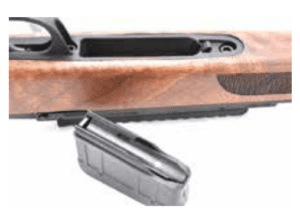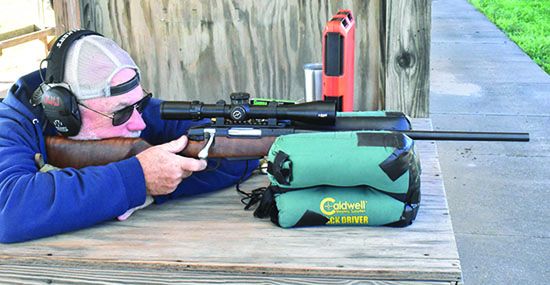The current “cool” trend among rifle enthusiasts seems to be long-range disciplines. Especially for the PRS game, 6mm rifles rule. Those chamberings offer good downrange performance, the ability to buck the wind well, and to do so with recoil light enough to allow the shooters to spot their hits and misses. We talked to the folks at RCBS recently, and they confirmed the popularity of the likes of the 6 Dasher, 6 BR, 6 BRA, and 6 Creedmoor chamberings in their competition die sales. Interestingly, the most famous of all the 6mms, the 243 Winchester, is conspicuously absent from that list. At least, that is, until you look at their sales of hunting-class dies, and then the 243 is in the top ten.
Some of our readers who hunt told us that they wanted to hear about rifles chambered in 243, so here we go. While we wanted to take a look at four quality rifles, we wanted to pick a quartet that wouldn’t break the bank. Our first selection is the Savage/Stevens Model 334 as imported from Turkey. Selling for a mere $425, this rifle sports a three-lug bolt and a real Turkish walnut stock. Next in line is the Savage Model 110, $760, with the outstanding Accustock and a trigger that was appreciated by this group of trigger snobs. Third is another rifle for the budget-minded in the guise of a Ruger American, $442. Batting cleanup is the Weatherby Vanguard First Lite, $923, the most expensive rifle in this test by a factor of two over the Ruger and the Stevens. The First Lite arrived with a camouflaged stock, Cerakoted action, fluted barrel, and a muzzle brake. It looks great, but was the shooting worth the extra cash? Let’s find out.
Stevens Model 334 18839 243 Winchester
$425
Gun Tests grade: B
The trigger could be improved, capacity increased, and the lines made a bit more pleasing to the eye. That said, this inexpensive rifle with Turkish walnut furniture shot okay in the beginning and got better as it broke in. If you want a wood stock, then this isn’t a bad pick.

| Action Type | Bolt, 3 lugs |
| Overall Length | 41.0 in. |
| Barrel | 20.0 in. long, 1:10 in. twist, matte-blue steel |
| Overall Height | 6.0 in. |
| Weight Unloaded | 7.6 lbs. |
| Weight Loaded | 7.8 lbs. |
| Action | Matte-blue steel |
| Magazine | 3-round detachable polymer box |
| Stock | Turkish walnut |
| Stock Drop at Comb | 0.5 in. |
| Stock Drop at Heel | 0.5 in. |
| Stock Bedding | Pillar |
| Stock Buttplate | Soft rubber |
| Stock Length of Pull | 14.5 in. |
| Receiver Scope-Base Pattern | Savage Model 110 |
| Trigger Pull Weight | 5.25 lbs. |
| Safety | 3-position, right side of receiver |
| Warranty | 1 year limited, original owner |
| Telephone | (800) 370-0708 |
| Website | SavageArms.com |
| Made In | Turkey |
It would appear that wildcatters are willing to try just about any case/bullet combination they can dream of. Short of a 17/50BMG, if you’ll invest the time, you can probably find where someone has tried it. Certain cartridge cases lend themselves well to duty as a parent case. Just look at the 404 Jeffrey. Quick research shows that piece of brass to be the genesis for the Remington Ultra Magnum Cartridges, Remington Short Action Ultras, Winchester Short Magnums, the Nosler cartridge line, and much more.
Another very popular parent case has been the 308 Winchester. It has been necked up to at least .358 inches, necked down to 6mm, and modified for most diameters in between. Perhaps the most popular has been the 243 Winchester. Once in a head-to-head contest with the 244 Remington for survival, the 243 Winchester, with a faster twist and a heavier bullet, won the popularity contest.
The last few years have seen the Turkish arms industry make a major play for the American market. SDS has imported Tokarev shotguns that we found to be well made and very affordable. Girsan has done the same thing for a number of handguns. Readers told us that they wanted to see more info on rifles from the Turks and to start with the Savage/Stevens Model 334. Since your wish is our command, we obtained a new wooden-stocked version chambered in 243 Winchester and went to work.
On inspection, we decided that the wood stock was both a plus and minus for the Model 334. First, the stock is made of Turkish walnut showing some decent figure, especially in the buttstock. At a measured 14.5 inches, the length of pull was a bit longer than we’re accustomed to. We actually prefer things to run a bit too short than too long — it makes shooting from field positions easier. The rifle sported a negative comb, which did a good job of pulling the recoil (such as it is with a 243) away from the shooter’s face. The checkering was pressed in and left a bit to be desired with some cross hatching showing on the fore end.

Still, the pattern and the location of checkering were good. The stock looks a little blocky to our eyes, with nothing approaching the lines of, say, a Remington 700 or a Winchester Model 70 Featherweight. Wood-to-metal fit was good. The barrel was free floated just enough to allow the passage of a business card between the tube and the stock. The rifle uses a metal block screwed into the stock just in front of the magazine. A mortise has been milled into the block. The front action screw taps through this block and into the recoil lug to tighten things down very well indeed. Add in two sling swivel studs to go with a fairly flat fore end, and the rifle worked well on a sling or a bench.
The action showed some unique lines of its own. The 20-inch barrel carried a medium profile measuring 0.71 inch in diameter at the muzzle and just over an inch at the receiver. It comes with a Picatinny rail mounted on four screws set in a Savage Model 110 pattern. The full-diameter bolt releases via pressing a lever on the left side of the receiver. We liked what we saw when it came out. The bolt sports three lugs allowing a 60-degree bolt throw instead of the more common 90-degree movement. It uses a spring-loaded plunger to go with an AR-15-like extractor. The bolt handle was swept to the rear and was easy to use. The bolt shroud was somewhat large and shaped to blend in with the rear of the receiver. The trigger looks to be adjustable, but not so fast — the instruction manual warns… “the trigger screw is fixed and is factory set, do not try to force it.” That lack of adjustment left us with a crunchy trigger we measured at 5.25 pounds, well above what we like to see in a good rifle. Remember, good triggers do not make a firearm more accurate, but they do make them easier to shoot accurately. The ejection port was just large enough to remove a loaded round, and the receiver was solid on top, adding more rigidity to the action. The safety is a three-position sliding switch on the right side of the receiver. We thought the position was well-chosen and easy to use. Forward is Fire, center is Safe, but the bolt can still be operated. Moving it to the rear locks the bolt as well.
The large action left us with another issue in that there was only room left for a three-round magazine if anything close to a flush fit was desired. The polymer bottom “metal” held everything securely and provided good protection for the polymer trigger.
The Stevens averaged just over 1.1-inch groups across the three different types of ammunition. It really seemed to settle in with about five groups left to shoot. The Sierra 90-grain Tipped GameKing load snuck in a 0.49-inch group and then the Barnes 80-grain TTSX averaged under an inch. We had to really focus on our trigger press, but it did the job.
Our Team Said: Some bolt-action rifles require that they be cycled quite a few times before they smooth out. The Stevens bolt operated smoothly from the beginning. Based on the price range and the heavy trigger, we have to confess that we weren’t expecting marvelous groups — and we were happily wrong. Still, the rifle’s grade took a hit on that trigger and the magazine capacity.
| 243 WINCHESTER RANGE DATA | ||||
| Barnes VOR-TX 80-grain TTSX BT | Ruger American | Savage Model 110 | Stevens Model 334 | Weatherby Vanguard |
| Average Velocity | 3166 fps | 3222 fps | 3126 fps | 3416 fps |
| Muzzle Energy | 1781 ft.-lbs. | 1844 ft.-lbs. | 1736 ft.-lbs. | 2073 ft.-lbs. |
| Average Group | 1.13 in. | 0.78 in. | 0.70 in. | 0.71 in. |
| Best Group | 1.21 in. | 0.91 in. | 0.97 in. | 0.96 in. |
| Sierra Gamechanger 90-grain TGK | Ruger American | Savage Model 110 | Stevens Model 334 | Weatherby Vanguard |
| Average Velocity | 3095 fps | 3135 fps | 3072 fps | 3149 fps |
| Muzzle Energy | 1915 ft.-lbs. | 1965 ft.-lbs. | 1886 ft.-lbs. | 1982 ft.-lbs. |
| Average Group | 0.95 in. | 0.96 in. | 0.49 in. | 1.14 in. |
| Best Group | 1.03 in. | 1.05 in. | 1.08 in. | 1.29 in. |
| Black Hills Gold 95-grain Hornady SST | Ruger American | Savage Model 110 | Stevens Model 334 | Weatherby Vanguard |
| Average Velocity | 2778 fps | 2817 fps | 2760 fps | 2872 fps |
| Muzzle Energy | 1628 ft.-lbs. | 1674 ft.-lbs. | 1608 ft.-lbs. | 1741 ft.-lbs. |
| Average Group | 0.45 in. | 0.9 in. | 1.16 in. | 1.06 in. |
| Best Group | 0.71 in. | 1.15 in. | 1.33 in. | 1.15 in. |
Written and photographed by Joe Woolley, using evaluations from Gun Tests Team members. GT



























